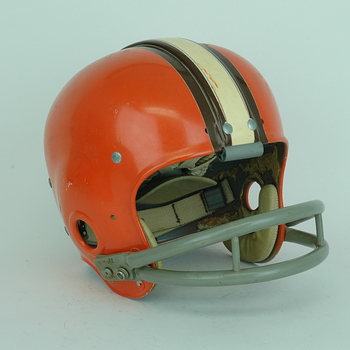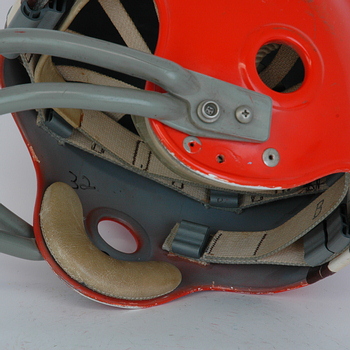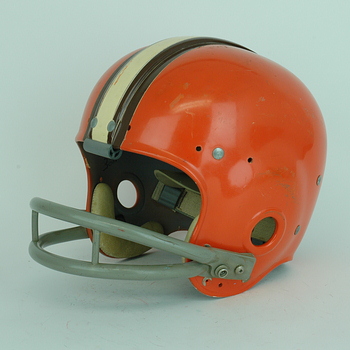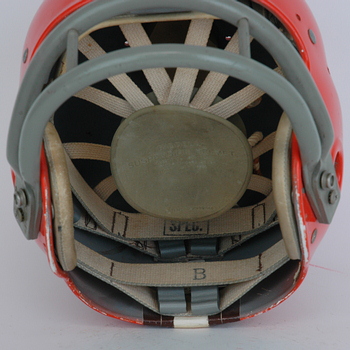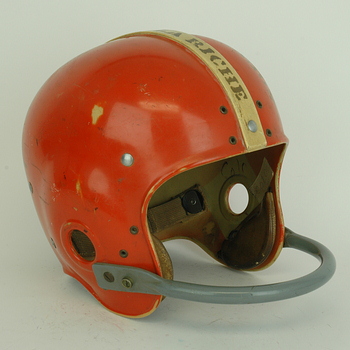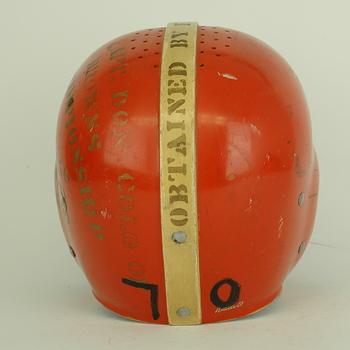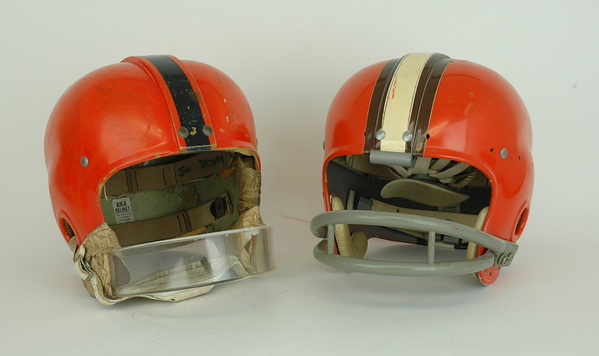
Cleveland Browns
Jim Brown Perfect & Priceless
As there is in any area
of human endeavor and perhaps in sports more than most, there is debate
regarding "the greatest" and what that title truly means. In professional
football, debates regarding "the greatest" at any position, as members of
the Pro Football Hall Of Fame, and in comparisons of players from one era
with another dominate conversation in locker rooms, sports bars, in front of
televised games, and among fans of all ages. However if there is one man,
one name, one presence that immediately comes to mind and could be the named
individual to cease any conversation or confusion on the matter, it is that
of James Nathaniel "Jim" Brown. His storied life and career have been
chronicled in articles, books, and documentaries, tracing a childhood that
began on St. Simon Island, Georgia and culminated in athletic greatness
in Manhasset, New York on Long Island. Blessed with physical strength and
athleticism from his father Swinton, a professional fighter, and a tireless
work ethic from Theresa, his mother who worked many weekly hours as a
domestic, Brown became a Long Island schoolboy legend.
By the time of his graduation, Jim Brown had solidified his reputation as
Manhasset High School and Long Island's premiere secondary school athlete.
Garnering thirteen letters in five sports, he was unstoppable on the
gridiron, rushing the football for an average gain of almost fifteen yards
per carry over the course of his career and very much serving as a one-man
team with his versatility. He scored 1142 points for a thirty-eight points
per game average on the basketball court and is still considered to be among
the greatest of all lacrosse players on Long Island which truly is "Lacrosse
Central." When his mentor, attorney and Syracuse University graduate Kenneth
Molloy, and legendary coach Ed Walsh saw him off to Syracuse, his collegiate
career that again won accolades in multiple sports introduced him to a
national audience. Finishing fifth in the Heisman Trophy voting of 1956 was
more a reflection of the disrespect voters had for Eastern football rather
than a disregard for Brown's enormous talent.
Jim Brown's professional
football statistics are in many ways ridiculous. He was usually so far ahead
of the pack that comparisons to him as the best at his position were rarely
made. In an era where 1000 yard rushers were rare and defenses were designed
to stop the run, Jim Brown was rarely stopped, leading the NFL in rushing in
eight of his nine seasons. In his one "off year" he gained 996 yards and his
nine year total of 12,312 yards was truly "other worldly" at the time. An
eight-time first team All Pro and a Pro Bowl selection in every one of his
professional seasons, Brown set a standard that was far greater than the
statistics show. In some games it hardly seemed fair that he was allowed to
play, such was his dominance. It wasn't his 126 career touchdowns that made
defenses key on him, but rather the knowledge that no matter what the
defensive intent, he could score a touchdown on any play. At times it
appeared as if he could in fact score at will and since his rookie season of
1957 the very greatest of NFL defenders have been quoted as saying that Jim
Brown was by far, the most dangerous, most devastating, and most destructive
running back ever to grace the gridiron. In every way he seemed to be a
super hero, never missing a game due to injury. His trademark slow-to-rise
and return to the huddle stroll often hid nicks and bruises but he was a
first-class warrior, never backing down and never showing pain. As the focal
point of every defense he faced in every game he played, Jim Brown earned
his way and earned the respect of his opponents. In 1971, six years after
his retirement, he earned his way into the Pro Football Hall Of Fame.
Brown has said, “People try to compliment me by saying I was the best
football player ever and I don’t need that… there is plenty of greatness to
share, look at Barry Sanders and Gayle Sayers… they were great too. I don’t
need to be the best. We can all be champions.” It is a simple and humble
statement but it is a fact that no matter the era, one's team affiliation,
or the perspective taken from that of a fan, analyst, or expert, Jim Brown
is to most, the absolute greatest player in the game's history. His
on-the-field presence altered every game he was in and he changed the
destiny of so many games. It is an arguable point but no one has denied that
Brown in the least, deserves consideration as the best of the best. For
collectors, this of course means that owning an authentic piece of Jim
Brown's uniform is the equivalent of owning a piece of football history, one
of its best pieces.
Mr. Robert E. Hughes was
over the course of his career, one of the most influential politicians in
the Cleveland and northeastern Ohio area. As the Cuyahoga County Republican
Party Chairman he earned a reputation as a man who could buck the larger
Democratic machine and get Republican candidates successfully ensconced in
both local office and in the Ohio Governor's mansion. Hughes was
instrumental in launching the career of pioneering African American
politician Virgil E. Brown, Cleveland councilman, Cuyahoga County Board of
Elections Director, and Cuyahoga County Commissioner. Having the power and
persuasiveness to convince the political party and populace to break the
color barrier in the public arena of politics, he was an important
individual in Cleveland. A man who "knew everyone" and who was as equally
popular as he was known, he listed Cleveland Browns owner Art Modell as a
dear friend and associate as quickly as Mr. Modell noted to others that Mr.
Hughes was his closest friend. May 22, 1971 began a rather significant day
in the Hughes household because as a token of that friendship, Modell
presented Jimmy Brown's helmet to Robert Hughes. The devotion that the
family had to the Browns, as so many Browns fans have so often demonstrated,
became more intensified as the great Jim Brown's practice helmet became one
of the family's most treasured possessions in their Lyndhurst, Ohio home.
As the favorite player
on the favorite team of Mr. Hughes' son, the gift served as a lifetime reminder
of his eleventh birthday and certainly a distinct memory to cherish. During our
mission to confirm and document this helmet, Mr. Modell noted just last year
when we spoke with him that "Anything that Bob (Hughes) received from the
Cleveland Browns organization would have come through me and if he had asked for
something for his son's birthday I certainly would have given it to him." Modell
could not recall the exact helmet provided to the family but it was one of Jim
Brown's practice helmets, not an extravagant gift at the time, since the younger
Mr. Hughes also recalled another birthday where Mr. Modell sent one of his
representatives to the party for the express purpose of showing reels of Jim
Brown's game films to all of the guests. Not surprisingly, Mr. Robert Hughes was
friendly with the Browns original founding family, the McBride's and the Hughes
children had access to McBride's fifty-yard line seats for many games.
For approximately forty years
this collectible gem sat on the bookcase of that eleven year old birthday boy
until it was moved to a display case in his son's room. Keeping Brown's helmet
company and sharing space with one of Jim Brown's most distinctive uniform items
has been a 1954 Browns helmet that had been worn in that season's NFL
Championship Game by Don Colo.
Don Colo game worn helmet
Jim Brown's extra wide "Husky"
Riddell RK 2 helmet (Same style worn at Syracuse) demonstrates the RK flared
sides and twelve-point suspension webbing. Brown's number 32 is written in
marker on both the outside and inside of the helmet for easier player
identification during practices. The two bar face mask is exactly what Brown
wore during actual game action though this specific helmet has additional
holes that were drilled for the attachment of a protective side bracket for
jaw injuries. Viewed from any angle, the original orange factory paint, the
striping, factory stampings and the distinctive handwritten numerals oozes
history and nostalgia. That the helmet belonged to perhaps the greatest
player in National Football League history, offers a distinction that will
forever be difficult to match.
Side by side, the only two Jim Brown helmets that have made it to public
light


